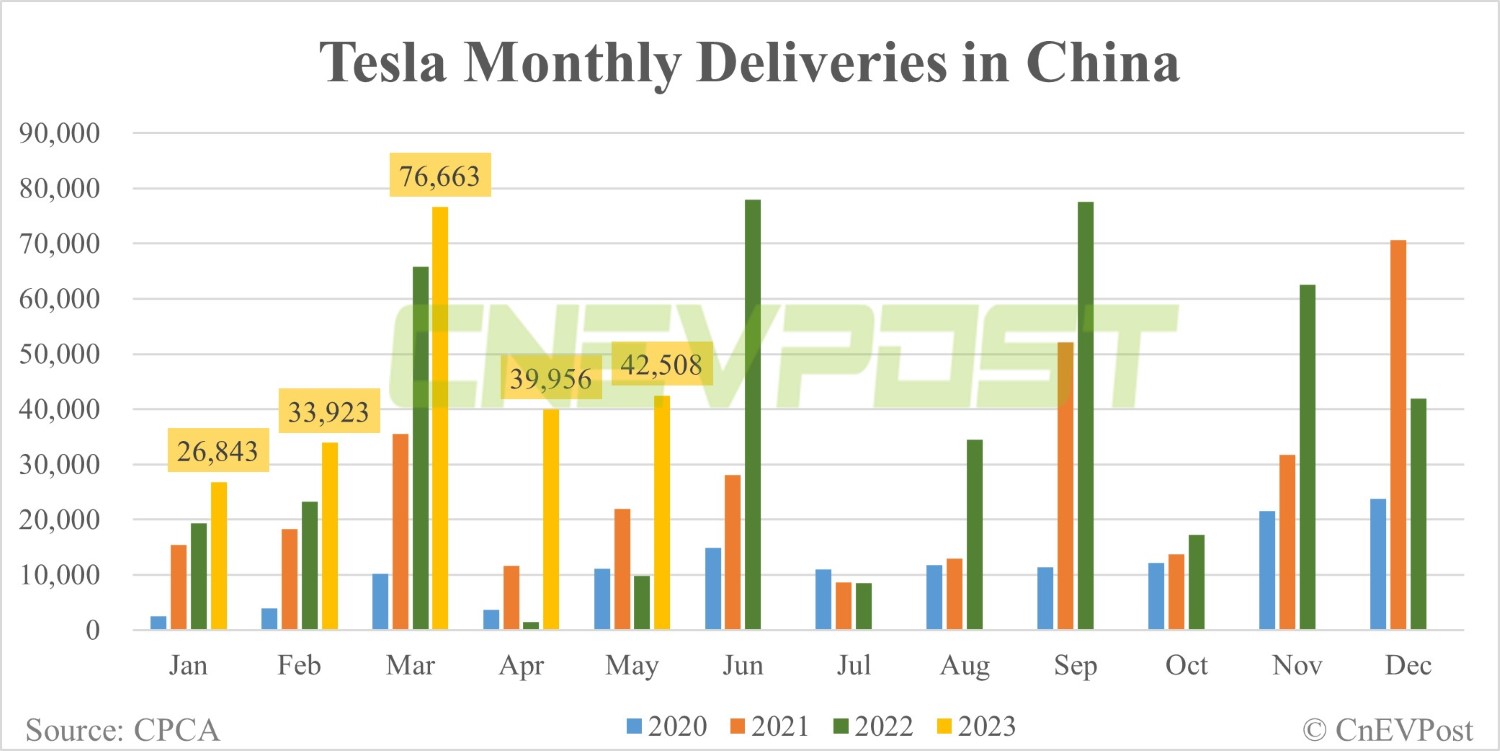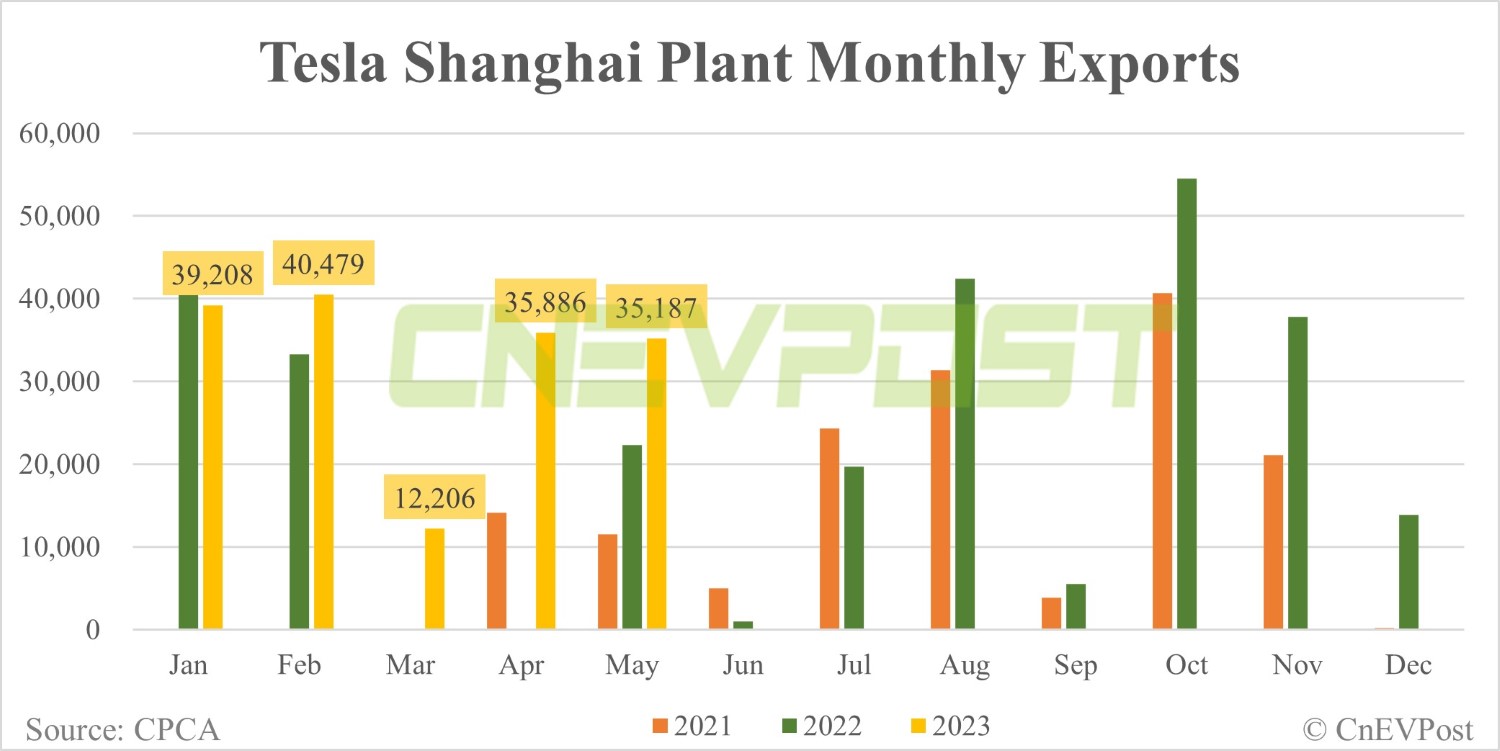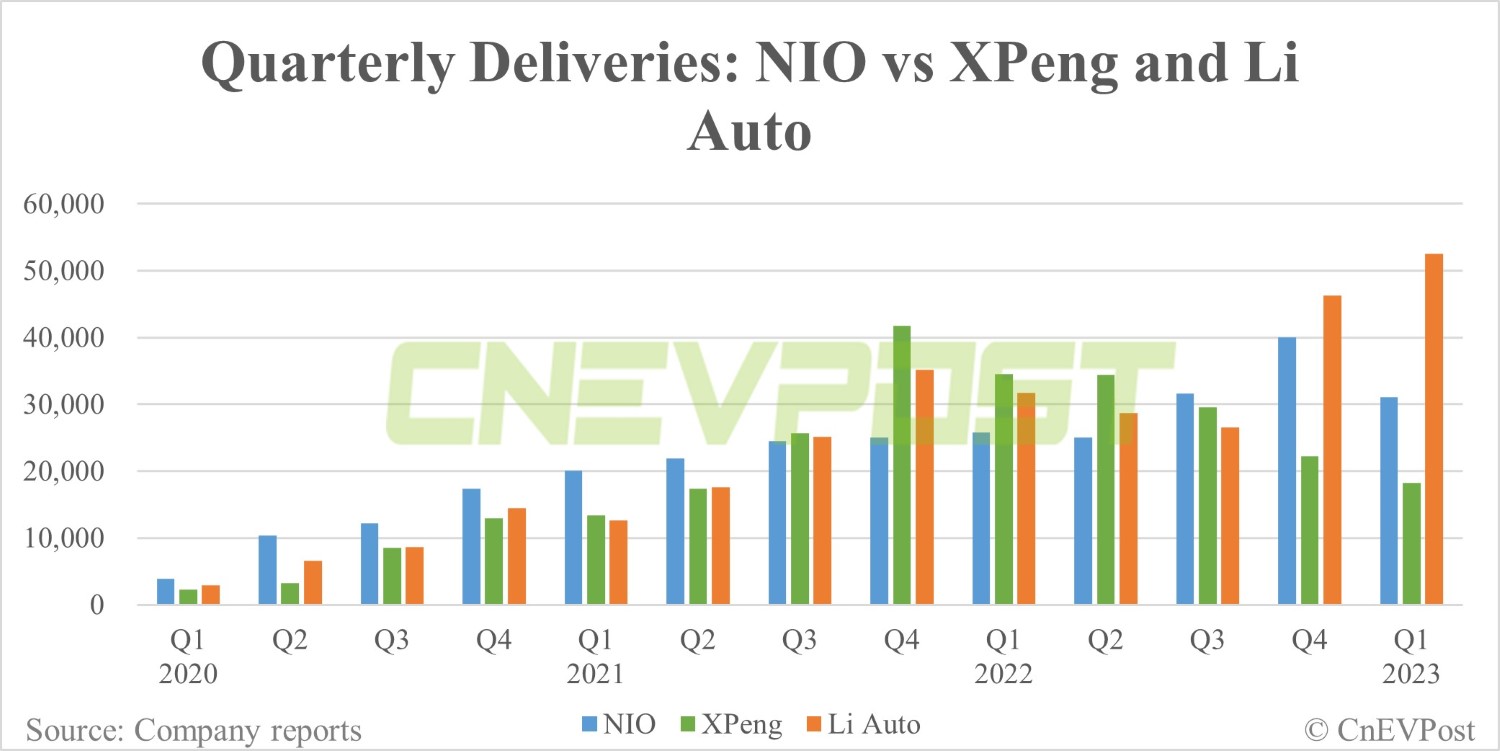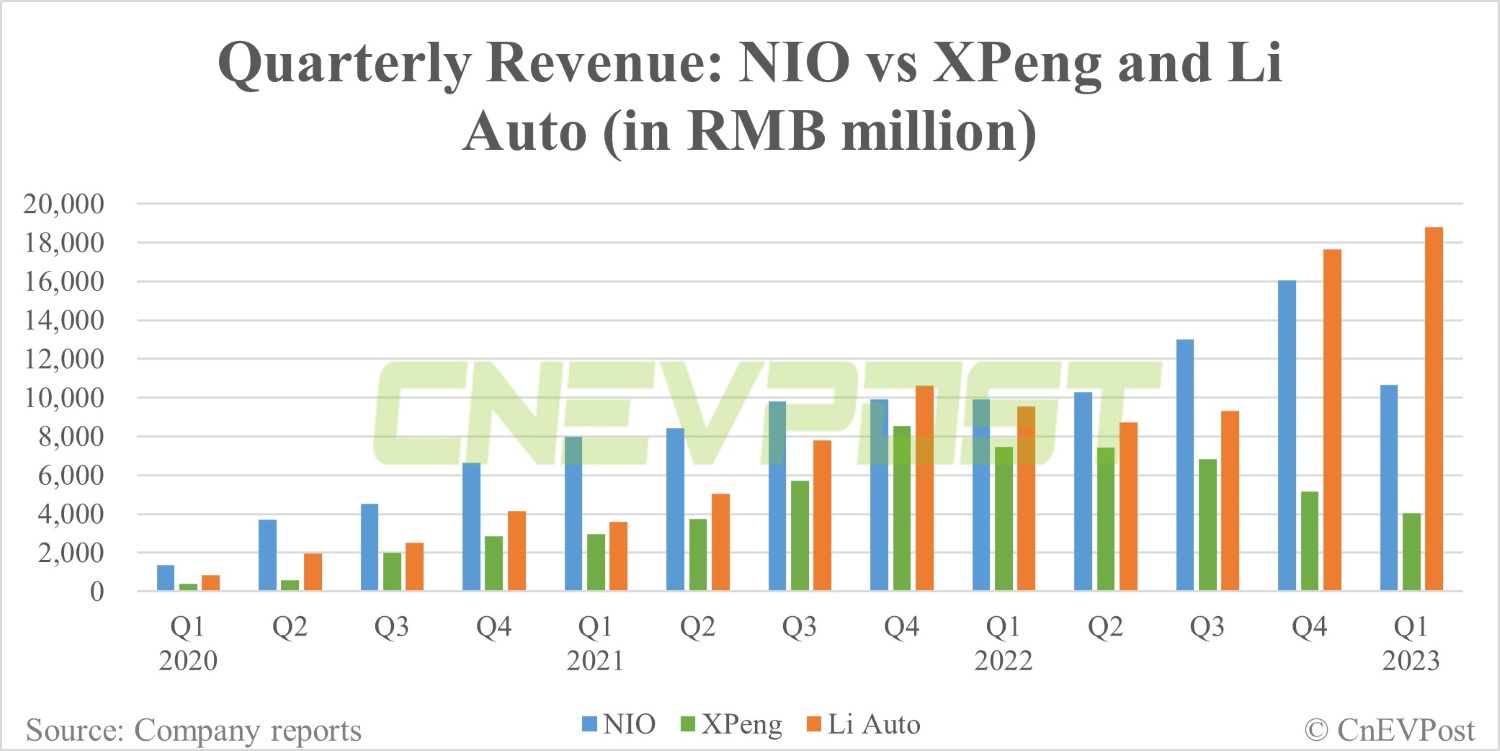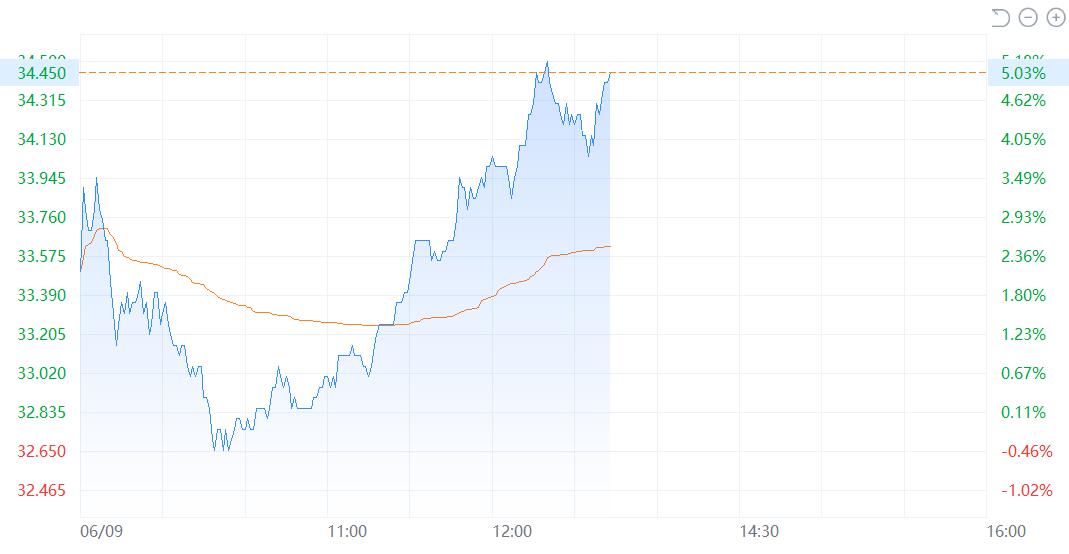
NIO reported revenue of RMB 10.68 billion in the first quarter, below market expectations of RMB 12.275 billion, compared to RMB 9.911 billion in the same period last year.
Previous data showed that NIO delivered 31,041 vehicles in the first quarter, slightly above the lower end of the guidance range of 31,000 to 33,000 vehicles.

NIO's previous revenue guidance for the first quarter was between RMB 10.93 billion and RMB 11.54 billion.


Below is its press release, as the CnEVPost article is being updated.
otal revenues in the first quarter of 2023 were RMB10,676.5 million (US$1,554.6 million), representing an increase of 7.7% from the first quarter of 2022 and a decrease of 33.5% from the fourth quarter of 2022.
Vehicle sales in the first quarter of 2023 were RMB9,224.5 million (US$1,343.2 million), representing a decrease of 0.2% from the first quarter of 2022 and a decrease of 37.5% from the fourth quarter of 2022. The decrease in vehicle sales over the first quarter of 2022 was mainly due to lower average selling price as a result of higher proportion of ET5 and 75 kWh standard-range battery pack deliveries, partially offset by an increase in delivery volume.
The decrease in vehicle sales over the fourth quarter of 2022 was mainly due to a decrease in delivery volume, and lower average selling price as a result of higher proportion of ET5 and 75 kWh standard-range battery pack deliveries.
Other sales in the first quarter of 2023 were RMB1,452.0 million (US$211.4 million), representing an increase of 117.8% from the first quarter of 2022 and an increase of 11.3% from the fourth quarter of 2022.
The increase in other sales over the first quarter of 2022 was mainly due to the increase in sales of accessories, provision of repair and maintenance services, provision of auto financing services, sales of used cars and provision of power solutions, as a result of continued growth of our users.
The increase in other sales over the fourth quarter of 2022 was mainly due to the increase in provision of auto financing services, sales of accessories, provision of repair and maintenance services, provision of power solutions and sales of used cars, as a result of continued growth of our users, and partially offset by a decrease in revenue from rendering of research and development services.
Cost of Sales and Gross Margin
Cost of sales in the first quarter of 2023 was RMB10,514.2 million (US$1,531.0 million), representing an increase of 24.2% from the first quarter of 2022 and a decrease of 31.9% from the fourth quarter of 2022.
The increase in cost of sales over the first quarter of 2022 was mainly driven by the increase in (i) delivery volume, and (ii) cost from the sales of accessories, provision of repair and maintenance services, sales of used cars and provision of power solutions, associated with increased vehicle sales and expanded power and service network. The decrease in cost of sales over the fourth quarter of 2022 was mainly attributed to (i) the decrease in delivery volume, (ii) the decrease in average material cost per vehicle as a result of higher proportion of ET5 and 75 kWh standard-range battery pack deliveries, and (iii) the inventory provisions, accelerated depreciation on production facilities, and losses on purchase commitments related to the previous generation of ES8, ES6 and EC6 in the fourth quarter of 2022.
Gross profit in the first quarter of 2023 was RMB162.3 million (US$23.6 million), representing a decrease of 88.8% from the first quarter of 2022 and a decrease of 73.9% from the fourth quarter of 2022.
Gross margin in the first quarter of 2023 was 1.5%, compared with 14.6% in the first quarter of 2022 and 3.9% in the fourth quarter of 2022. The decrease of gross margin from the first quarter of 2022 and the fourth quarter of 2022 was mainly attributed to the decreased vehicle margin.
Vehicle margin in the first quarter of 2023 was 5.1%, compared with 18.1% in the first quarter of 2022 and 6.8% in the fourth quarter of 2022. The decrease in vehicle margin from the first quarter of 2022 was mainly attributed to changes in product mix and increased battery cost per unit.
The decrease in vehicle margin from the fourth quarter of 2022 was mainly due to (i) changes in product mix, and (ii) increased promotion discount for the previous generation of ES8, ES6 and EC6, which were partially offset by (iii) the inventory provisions, accelerated depreciation on production facilities, and losses on purchase commitments for the previous generation of ES8, ES6 and EC6 in the fourth quarter of 2022.
Operating Expenses
Research and development expenses in the first quarter of 2023 were RMB3,075.6 million (US$447.8 million), representing an increase of 74.6% from the first quarter of 2022 and a decrease of 22.7% from the fourth quarter of 2022.
Excluding share-based compensation expenses, research and development expenses (non-GAAP) were RMB2,711.6 million (US$394.8 million), representing an increase of 79.1% from the first quarter of 2022 and a decrease of 23.7% from the fourth quarter of 2022. The increase in research and development expenses over the first quarter of 2022 was mainly attributed to the increased personnel costs in research and development functions and the increased share-based compensation expenses recognized in the first quarter of 2023.
The decrease in research and development expenses over the fourth quarter of 2022 reflected fluctuations due to different design and development stages of new products and technologies.
Selling, general and administrative expenses in the first quarter of 2023 were RMB2,445.9 million (US$356.2 million), representing an increase of 21.4% from the first quarter of 2022 and a decrease of 30.7% from the fourth quarter of 2022.
Excluding share-based compensation expenses, selling, general and administrative expenses (non-GAAP) were RMB2,239.3 million (US$326.1 million), representing an increase of 24.3% from the first quarter of 2022 and a decrease of 31.2% from the fourth quarter of 2022.
The increase in selling, general and administrative expenses over the first quarter of 2022 was mainly attributed to (i) the increase in personnel costs related to sales and general corporate functions, and (ii) the increase in expenses related to the Company's sales and service network expansion. The decrease in selling, general and administrative expenses over the fourth quarter of 2022 was mainly due to the decrease in sales and marketing activities and professional services.
Loss from Operations
Loss from operations in the first quarter of 2023 was RMB5,111.8 million (US$744.3 million), representing an increase of 133.6% from the first quarter of 2022 and a decrease of 24.1% from the fourth quarter of 2022. Excluding share-based compensation expenses, adjusted loss from operations (non-GAAP) was RMB4,522.4 million (US$658.5 million) in the first quarter of 2023, representing an increase of 163.6% from the first quarter of 2022 and a decrease of 24.8% from the fourth quarter of 2022.
Net Loss and Earnings Per Share/ADS
Net loss in the first quarter of 2023 was RMB4,739.5 million (US690.1 million), representing an increase of 165.9% from the first quarter of 2022 and a decrease of 18.1% from the fourth quarter of 2022. Excluding share-based compensation expenses, adjusted net loss (non-GAAP) was RMB4,150.1 million (US604.3 million) in the first quarter of 2023, representing an increase of 216.9% from the first quarter of 2022 and a decrease of 18.1% from the fourth quarter of 2022.
Net loss attributable to NIO's ordinary shareholders in the first quarter of 2023 was RMB 4,803.6 million (US$699.5 million), representing an increase of 163.2% from the first quarter of 2022 and a decrease of 17.8% from the fourth quarter of 2022. Excluding share-based compensation expenses and accretion on redeemable non-controlling interests to redemption value, adjusted net loss attributable to NIO's ordinary shareholders (non-GAAP) was RMB 4,141.8 million (US$603.1 million) in the first quarter of 2023.
Basic and diluted net loss per ordinary share/ADS in the first quarter of 2023 were both RMB2.91 (US$0.42), compared with RMB1.12 in the first quarter of 2022 and RMB3.55 in the fourth quarter of 2022. Excluding share-based compensation expenses and accretion on redeemable non-controlling interests to redemption value, adjusted basic and diluted net loss per share/ADS (non-GAAP) were both RMB2.51 (US$0.36), compared with RMB0.79 in the first quarter of 2022 and RMB3.07 in the fourth quarter of 2022.
Balance Sheet
Balance of cash and cash equivalents, restricted cash, short-term investment and long-term time deposits was RMB37.8 billion (US$5.5 billion) as of March 31, 2023.
Business Outlook
For the second quarter of 2023, the Company expects:
Deliveries of vehicles to be between 23,000 and 25,000 vehicles, representing a decrease of approximately 8.2% to 0.2% from the same quarter of 2022.
Total revenues to be between RMB8,742 million (US$1,273 million) and RMB9,370 million (US$1,364 million), representing a decrease of approximately 15.1% to 9.0% from the same quarter of 2022.
The post NIO reports weaker-than-expected Q1 earnings, gross margin falls to 1.5% appeared first on CnEVPost.
For more articles, please visit CnEVPost.




